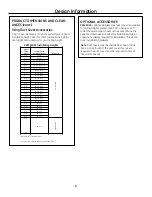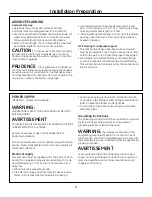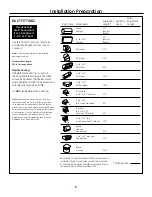
Installation Preparation
5
ADVANCE PLANNING
Ductwork Planning
• Determine the exact location of the vent hood.
• Plan the route for venting exhaust to the outdoors.
• Use the shortest and straightest duct route possible. For
satisfactory performance, duct run should not exceed
100 equivalent length for any duct configurations.
• Refer to “Duct Fittings” chart to compute the maximum
permissible length for duct runs to the outdoors.
CAUTION:
To reduce risk of fire and to properly
exhaust air, be sure to duct air outside–Do not vent ex-
haust air into spaces within walls or ceilings or into attics,
crawl spaces or garages.
PRUDENCE
– Il faut prendre soin d’installer un
conduit vers l’extérieur pour réduire le risque d’incendie et
pouvoir évacuer l’air correctement. Il ne faut pas évacuer
l’air dans l’espace entre les parois d’un mur, un plafond ou
un grenier, un espace sanitaire ou un garage.
POWER SUPPLY
IMPORTANT – (Please read carefully)
WARNING:
FOR PERSONAL SAFETY, THIS APPLIANCE MUST BE PROP-
ERLY GROUNDED.
AVERTISSEMENT
POUR DES RAISONS DE SÉCURITÉ, CET APPAREIL DOIT ÊTRE
CORRECTEMENT MIS À LA TERRE.
Remove house fuse or open circuit breaker before
beginning installation.
Do not use an extension cord or adapter plug with this ap-
pliance. Follow National Electrical Code or prevailing local
codes and ordinances.
Electrical supply
This vent hood must be supplied with 120V, 60Hz, and con-
nected to an individual, properly grounded branch circuit,
and protected by a 15 or 20 amp circuit breaker or time
delay fuse.
• Wiring must be 2 wire with ground.
• If the electrical supply does not meet the above require-
ments, call a licensed electrician before proceeding.
• Use metal ductwork. These hoods must use 8" round
duct. It can transition to 3-1/4" x 12", reducing the maxi-
mum equivalent duct length to 75 feet.
• Install a wall cap with damper or roof cap at the exterior
opening. Order the wall or roof cap and any transition
needed in advance.
Wall Framing for Adequate Support
• This vent hood is heavy. Adequate structural support
must be provided. The hood must be secured to vertical
studs in the wall, or to a horizontal support. See page 9.
• We strongly recommend that the vent hood with duct
cover be on site before final framing and wall finishing.
This will also help to accurately locate the ductwork and
electrical service.
• Route house wiring as close to the installation location
as possible in the ceiling or soffit. Wiring should enter at
least 4" above the bracket on the right side.
• Connect the wiring to the house wiring in accordance
with local codes.
Grounding instructions
The grounding conductor must be connected to a ground
metal, permanent wiring system, or an equipment-
grounding terminal or lead on the hood.
WARNING:
The improper connection of the
equipment-grounding conductor can result in a risk of
electric shock. Check with a qualified electrician or service
representative if you are in doubt whether the appliance is
properly grounded.
AVERTISSEMENT
Le mauvais branchement du fil de mise à la terre peut
causer un choc électrique. En cas de doute, consulter un
électricien qualifié ou un technicien pour déterminer si
l’appareil est à la terre.






























